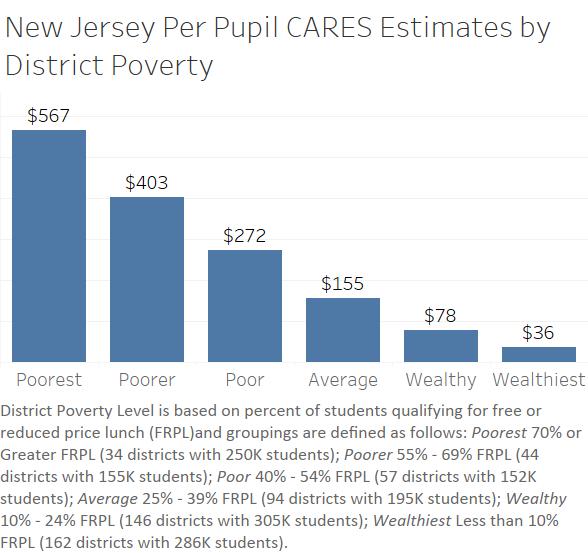ELC CALLS ON NJ TO USE CARES ACT FUNDS TO END DIGITAL DIVIDE AND ADDRESS EDUCATION INEQUITIES
Education Law Center is urging New Jersey Governor Phil Murphy to promptly issue guidance to local school districts to prepare plans for using the federal emergency funds under the Coronavirus Aid, Relief, and Economic Security Act (CARES Act) earmarked for New Jersey K-12 education. The purpose of administration guidance is to ensure districts across the state use these additional resources to close the “digital divide” and address other education inequities between poorer and wealthier districts and among disadvantaged student groups, including low-income students, students with disabilities, students of color and English language learners.
ELC’s call to action is spelled out in a May 1 letter sent to Governor Murphy and education officials in his administration. ELC also released an estimate of the distribution of the $310 million in the Elementary and Secondary Emergency Relief Fund under the CARES Act on a district-by-district basis across the state. New Jersey will also receive $69 million in the Governor’s Emergency Education Relief Fund for both K-12 and higher education.
In the CARES Act, Congress targeted the K-12 emergency relief funds to enable school districts to address glaring resource gaps that prevent the delivery of continuous instruction during school closure to all students through remote, virtual means, including internet connectivity, devices, online learning platforms, assistance and training for teachers, and meals and other student supports. State education agencies – in New Jersey, the Department of Education (NJDOE) – will allocate the funds to school districts using the existing formula in Title I-A of the Every Student Succeeds Act (ESSA), the longstanding federal program that provides funding for the nation’s low-income students.
Because the CARES Act uses the Title I formula, the distribution of emergency relief funds to districts will be “progressive,” that is, providing greater levels of funding to higher poverty districts and, as a result, districts with greater student need.
As ELC’s analysis of the district allocation of funds shows, the CARES Act delivers $567 per pupil in New Jersey’s highest poverty districts – those with over 70% poor students – gradually declining to $36 per pupil in the wealthiest districts. The statewide average is $283 per pupil.

ELC is urging Governor Murphy to direct each district to submit CARES Act plans for NJDOE approval that identify and document the digital divide among vulnerable subgroups of students and demonstrate how the district will provide equitable access to continuous remote instruction to close that divide. Further, districts should be required to demonstrate how their plans support programs and practices that will reduce education inequities during and after school closures.
ELC is also calling on Governor Murphy to allocate federal funds from the Governor’s Emergency Relief Fund for the NJDOE to immediately launch a statewide research initiative to collect and analyze data on the digital divide between high poverty and more affluent districts and among disadvantaged student groups during this period of school closure. This research is essential to inform the efforts of the Administration to safely reopen schools with sufficient compensatory education resources to accelerate students’ instructional progress as quickly as possible.
“The federal CARES Act funds provide much-needed resources to connect all New Jersey students to online and continuous learning,” said David Sciarra, ELC Executive Director. “There is a digital divide in our state across lines of poverty, race, disability and other factors that put students at-risk while sheltering at home. It’s time to permanently close that divide.”
Press Contact:
Sharon Krengel
Policy and Outreach Director
skrengel@edlawcenter.org
973-624-1815, x 24
Press Contact:
Sharon Krengel
Director of Policy, Strategic Partnerships and Communications
skrengel@edlawcenter.org
973-624-1815, x240